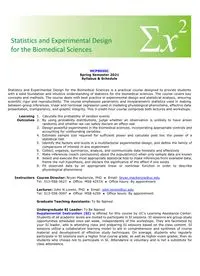
mcp8050c-statistics-and-experimental-design-ss20 smp-handbook-version PDF
Preview mcp8050c-statistics-and-experimental-design-ss20 smp-handbook-version
MCP8050C Spring Semester 2021 Syllabus & Schedule Statistics and Experimental Design for the Biomedical Sciences is a practical course designed to provide students with a solid foundation and intuitive understanding of statistics for the biomedical sciences. The course covers key concepts and methods. The course deals with best practice in experimental design and statistical analysis, ensuring scientific rigor and reproducibility. The course emphasizes parametric and nonparametric statistics used in making between-group inferences, linear and nonlinear regression used in modeling physiological phenomena, effective data presentation, transparency, and graphic integrity. This 3-credit-hour course comprises both lectures and workshops. Learning Outcomes 1. Calculate the probability of random events 2. By using probability distributions, judge whether an observation is unlikely to have arisen randomly and whether we can safely declare an effect real 3. Design powerful experiments in the biomedical sciences, incorporating appropriate controls and accounting for confounding variables 4. Estimate sample size required for sufficient power and calculate post hoc the power of a statistical test 5. Identify the factors and levels in a multifactorial experimental design, and define the family of comparisons of interest in any experiment 6. Collect, organize, summarize, analyze, and communicate data honestly and effectively 7. Make inferences (reach conclusions) about the population(s) when only sample data are known 8. Select and execute the most appropriate statistical test to make inferences from available data, frame the null hypothesis, and declare the significance of the effect if one exists 9. Fit observed data by an appropriate linear or nonlinear function in order to describe physiological phenomena Instructors Course Director: Bryan Mackenzie, PhD ● Email:
